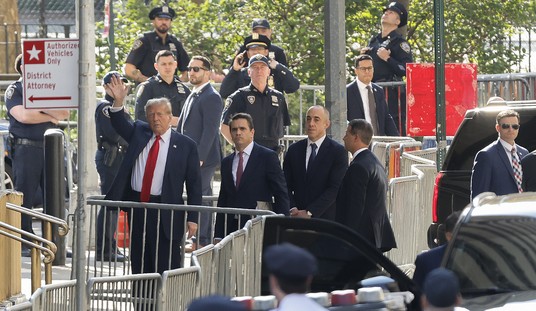The Washington Post recently described a possible plan to strike at targets within Pakistan in the event of a major attack on the US originating from there . Anonymous officials quoted by the Post “stressed that a U.S. reprisal would be contemplated only under extreme circumstances, such as a catastrophic attack that leaves President Obama convinced that the ongoing campaign of CIA drone strikes is insufficient.” The article is fairly complimentary, but a Heritage Foundation blog is not impressed, calling it a sad attempt at deterrence by press release, one of many recent efforts by the administration that try “to look conciliatory and humble and at the same time ‘reserved the right’ to look tough” and wind up, in Heritage’s estimate, doing neither.
Heritage writes that “military contingency planning is supposed to be secret. Why this information is getting out is far from clear.” It argues that by telegraphing its moves the administration is giving its enemies time to clear out. Moreover, it tells American enemies all over the world (if any may be so called now that the War on Terror is over) that America will be reactive. It will only strike if a catastrophic attack threshold has been passed. The Heritage blog says:
If it is meant as a deterrent–forget it. Odds are if al Qaeda and the Taliban knew they could prompt attacks on Pakistan by striking the US they would just up their efforts–knowing that large-scale unilateral strikes on Pakistan would put US and Pakistani officials at each others throats. Plus, thanks for the heads-up, America! Now, they can start taking countermeasures–dispersing more widely, hiding in the cities. …
Problem Two. If letting this out is supposed to make the administration “look tough”–forget that too. Basically, what this says is that we are going to wait for the next 9/11–just like last time–and then respond. That is just idiotic …
But no great disruptions may occur because the nuanced policymakers have balanced threat with reassurance. To forestall any Pakistani suspicion that America may strike at them, the Washington Post also reports that the administration is pushing for closer partnership with the ISI, chiefly by admitting them to intelligence “fusion centers”. In that way the ISI can see for itself exactly what American capabilities are; where US forces are deployed and at what targets the US strike. Armed with such reassuring knowledge, the Pakistani authorities are less likely to object to any unilateral strike when it comes, because they know who the possible targets are. The Post continues:
In the Peshawar fusion cell, which was set up within the last several months, Pakistanis have access to “full-motion video from different platforms,” including unarmed surveillance drones, one official said.
The fusion centers also serve a broader U.S. aim: making the Pakistanis more dependent on U.S. intelligence, and less likely to curtail Predator drone patrols or other programs that draw significant public opposition.
To Pakistan, the fusion centers offer a glimpse of U.S. capabilities, as well as the ability to monitor U.S. military operations across the border. “They find out much more about what we know,” one of the senior U.S. military officials said. “What we get is physical presence — to see what they are actually doing versus what they say they’re doing.”
That delicate arrangement will be tested if the two sides reach agreement on the fusion center near Quetta. The city has served for nearly a decade as a sanctuary for Taliban leaders who fled Afghanistan in 2001 and have long-standing ties to Pakistan’s powerful Inter-Services Intelligence directorate.
Like gamblers on an old-time riverboat, the rule is all cards on top of the table. But it might hard to figure out whether the Pakistanis are holding out because of restrictions on the taking of prisoners make it difficult to check. Special Operations tried it once and it got objected to. US Special Operations Forces have repeatedly asked for permission to take prisoners for interrogation instead of relying of “CIA drone strikes [which] do not yield prisoners or other opportunities to gather intelligence”. The Washington Post says “a 2008 U.S. helicopter raid against a target in Pakistan prompted protests from officials in Islamabad who oppose allowing U.S. soldiers to operate within their country.”
So now the US is out of the prisoner interrogation game. One factor hampering the US is where to put such prisoners. A Reuters article datelined May 18, 2010 reported that after the closure of Guantanamo Bay “there is nowhere to put them”; and so they are simply blown up by the CIA.
Presumably the Pakistanis can still take prisoners. Recently one of the suspects in the recent Times Square bomb attack, a former major in the Pakistani Army, was arrested by Pakistani intelligence. They subsequently released him after clearing him “of any wrongdoing”. However, the major in question was dismissed from the military in the first place “because he had ties to banned organizations” the extent of which Islamabad would not reveal. These and other circumstances provide reasons to suspect the Times Square incident itself may have roots within the Pakistani military — the American partners in the fusion centers.
Adnan Ahmad and his brother were among at least 11 people that Pakistan has rounded up since the failed attack May 1. Two other suspects face allegations of involvement in the plot, but no one in Pakistan has been charged.
Ahmad’s detention was especially sensitive because of ongoing U.S. suspicion that elements in Pakistan’s military and intelligence world who are sympathetic to Islamist causes have assisted would-be jihadists. … The main suspect in the car bomb case, Pakistani-American Faisal Shahzad, is being held by U.S. authorities. Shahzad is the son of a former Pakistani air force officer.
The Times Square bomber was the son of not just any air force officer, but of former Pakistani Air Vice Marshal Baharul Haq. The former Air Vice Marshal hurriedly left his home in the aftermath of the Times Square bombing report. A Pakistani newspaper explains:
Air Vice Marshal (R) Baharul Haq, father of Faisal Shahzad, the accused in New York’s failed bomb plot, hurriedly vacated the family home in Hayatabad town here late Tuesday apparently to avoid attention. Eyewitnesses said he packed some belongings in a vehicle and left the house located in Phase IV of the posh Hayatabad town along with male and female members of the family. Their destination wasn’t known.
“Hold your friends close but your enemies closer” may be a good adage for a gangster movie, but it should never be used as a rationale for admitting your enemies into council. A suspicious person might want to independently check on the reliability of America’s Pakistani allies before showing them the Crown Jewels. The desire to obtain an alternative channel of intelligence may be one reason why General David Petraeus signed a secret order in September 2009 to send “American Special Operations troops to both friendly and hostile nations in the Middle East, Central Asia and the Horn of Africa to gather intelligence and build ties with local forces. Officials said the order also permits reconnaissance that could pave the way for possible military strikes in Iran if tensions over its nuclear ambitions escalate. ” Petraeus was creating an collateral source of intel through the secret order. But it is secret no more. The New York Times, leaked the order, explaining:
The order, which an official said was drafted in close coordination with Adm. Eric T. Olson, the officer in charge of the United States Special Operations Command, calls for clandestine activities that “cannot or will not be accomplished” by conventional military operations or “interagency activities,” a reference to American spy agencies. … The seven-page directive appears to authorize specific operations in Iran, most likely to gather intelligence about the country’s nuclear program or identify dissident groups that might be useful for a future military offensive. …
some Pentagon officials worry that the expanded role carries risks. The authorized activities could strain relationships with friendly governments like Saudi Arabia or Yemen — which might allow the operations but be loath to acknowledge their cooperation — or incite the anger of hostile nations like Iran and Syria. Many in the military are also concerned that as American troops assume roles far from traditional combat, they would be at risk of being treated as spies if captured and denied the Geneva Convention protections afforded military detainees.
Ralph Peters, writing in the NY Post, calls the NYT article “just another act of deadly treason … yesterday, the New York Times published another front-page article based on a leaked classified document. This time, it was an order signed by Gen. David Petraeus authorizing black operations against adversaries and such dubious friends as Iran, Syria, Yemen and Saudi Arabia.”
But Peters could be wrong about the treason. Heritage speculates the leaks are at the behest of an administration eager to strike a balance; to “look tough” yet tip the US hand in such a way that neither Iran, Syria, Yemen, Saudi Arabia or even Pakistan feel remotely threatened. The New York Times might simply be using its front page as sixteen inch typeface ordnance in the service of engagement and diplomacy as suggested to it by “officials”. Far from being treason it is the ‘highest form of patriotism’. That Peters may fail to grasp the game is merely due to his incapacity to appreciate nuance; where the left can undo what the right hand does, in a demonstration of sophistication which the public, had it more wit, would regard with awe. In the game of Washington power chess, Petraeus checks and the NYT checkmates. But no treason was intended; that is only the way the game is played. Yet the Heritage Foundation may ultimately be correct. The administration may be outsmarting itself and imagining it is accomplishing something with these complicated maneuvers when it is really running around in circles. The American definition of the British phrase “too clever by half” may describe the Administration’s strategy more accurately than the original British sense. The Urban Dictionary says the phrase means:
is to be too smart for one’s own good, meant either literally or ironically. As an idiom, it is usually sarcastic. The phrase has a wide range of potential uses; for instance, it can mean: 1.) Something so complex that it’s self-obfuscating. 2.) A seemingly clever action that is in fact foolish. 3.) Logically accepting something as necessary that isn’t. 4.) Overanalysis. 5.) Elitism
But I think the better phrase is goatrope.
When good intentions go bad, messily. History: From LCDR Charles Breen, USN, who tried to untangle a goat’s rope, only to be bitten by said goat, then to deck same goat, Mongo style, right as busload of tourists rounded the bend in time to think he was beating the crap out of a goat for no reason. This definition dates back to at least 1988.









Join the conversation as a VIP Member